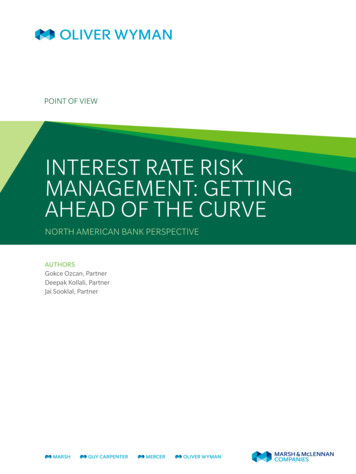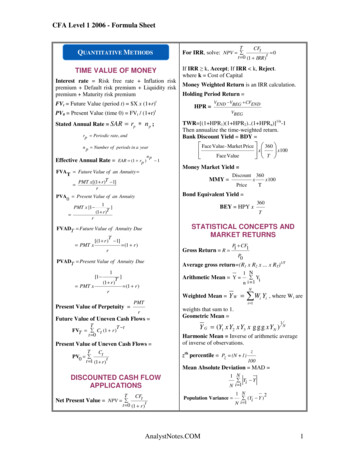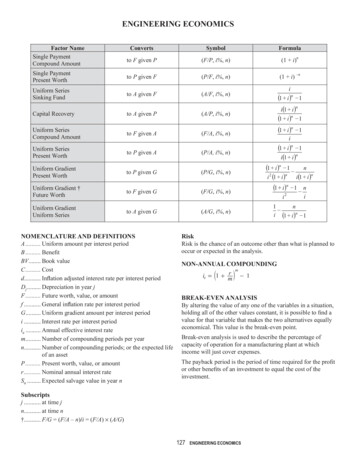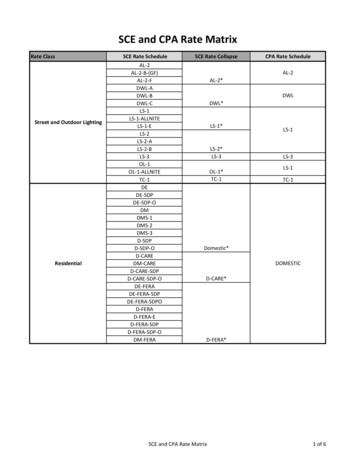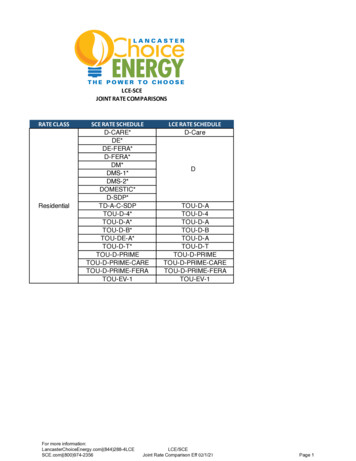
Transcription
Interest rate riskin banking book:The way aheadDecember 2017www.pwc.in
ContentsKey changes and their impactCapitalrequirementsDisclosure2 PwCIRRBBassumptionsInterest rate shockscenariosCapital assessmentunder ICAAPInterest rate stressscenariosData andmeasurement systemsReportingStandardisedframeworkInterest rate risk in banking book: The way ahead
Executive summaryInterest rate risk in banking book (IRRBB) refers to the current or prospective risk to a bank’s capital and earnings arising from adverse movements in interestrates that affect banking book positions.When interest rates change, the present value and timing of future cash flows change. This in turn changes the underlying value of a bank’s assets, liabilitiesand off-balance sheet items and, hence, its economic value of equity (EVE). Changes in interest rates also affect a bank’s earnings by altering interest ratesensitive income and expenses, thus affecting its net interest income (NII).Main components of IRRBBGap riskBasis riskOption risk Describes the risk arising from the timing ofinstruments’ rate changes. Derives from the term structure of banking bookinstruments.Describes the impact of relative changes in interestrates for financial instruments that have similartenures but are priced using different interest rateindices.Arises from optional elements embedded in thebank’s on- and off-balance sheet items, where thebank or its counterparty can alter the level and timingof its cash flows or from option derivative positions. The extent of gap risk depends on whetherthere’s a parallel or non-parallel shift in the yieldcurve and to what extent. Focuses on specific differences between instrumentsof a similar nature. Can be further categorised into automatic option andbehavioural option.IRRBB is a part of Pillar 2 of the Basel capital framework (Supervisory Review Process) and subject to the Basel Committee on Banking Supervision(BCBS) guidance set out in the 2004 Principles for the Management and Supervision of Interest Rate Risk (henceforth, the IRR Principles). The IRRPrinciples lay out the Committee’s expectations for banks’ identification, measurement, monitoring and control of IRRBB as well as banks’ supervision.On 2 February 2017, the RBI came up with draft guidelines focusing on the governance, measurement and management of IRRBB. The new guidelines arein line with the BCBS standards on IRRBB (finalised on April 2016). Banks in India are required to adhere to these guidelines from 1 April 2019.(BCBS 368)RBI released draftguidelines on IRRBB.March2019(BCBS 319)BCBS releasedrevised standards onIRRBB.February2017(BCBS 108)BCBS issued aconsultation paperto on IRRBB.April 2016BCBS released ‘Principles for themanagement and supervision ofinterest rate risk’.June 20152004The IRRBB landscapeBanks in India areexpected to implementstandards.This document details the various changes proposed in the guidelines and the possible impact on banks in India.3 PwCInterest rate risk in banking book: The way ahead
Key changes and their impactThe RBI expects banks to have a clearly defined risk appetite statementfor IRRBB which is approved by their board and to have proceduresfor approving major hedging or risk-taking initiatives. Banks shouldidentify the IRRBB inherent in all products and activities, integrate themanagement of their IRRBB within their broader risk managementframework as well as align the management of IRRBB with their businessplanning and budgeting activities. The board should have oversight of thepolicies, procedure, assumptions, deviations and mitigation plan.A bank should be able to compute IRRBB as impact on economic value(ΔEVE) and earnings (ΔNII) based on:1. internally selected interest rate shock scenarios addressing its riskprofile according to its Internal Capital Adequacy Assessment Process(ICAAP);2. historical and hypothetical interest rate stress scenarios, which tend tobe more severe than shock scenarios; and3. the six prescribed interest rate shock scenarios for EVE and twoscenarios for NII.PwC’s observations:To date, banks in India were required to adhere to interest rate risk (IRR)guidelines. Under IRRBB, only parallel shocks are used to calculate theabsolute level of change in NII levels. These guidelines are in addition to theexisting guidelines on IRR which are applicable to the entire balance sheet.PwC recommends that banks start working on these regulations assoon as possible. The regulations require a lot of homework in terms ondata integrity, historical data maintenance, market data modelling,cost of funding computation, product lives and cash flow modelling.Additionally, banks should focus on system capability upgrade tohandle a range of scenarios, higher tenure analysis and granularity.4 PwC1.1. Capital requirementsBanks are required to consider both the short-term and long-term perspectivesto identify the risks associated with changing IRRBB on their on-balancesheet and off-balance sheet exposures. Banks can decide, with the approval ofthe board, on the appropriate level of IRRBB which they would like to carrykeeping in view their capital level, interest rate management skills and theability to rebalance the banking book portfolios quickly in case of adversemovement in the interest rates.Banks whose IRRBB exposure is less than a 20% drop in the EVE may berequired to hold additional capital if the RBI considers the level of IRR to behigh in relation to the bank’s capital level or the quality of the bank’s IRRmanagement framework.While there is an explicit capital requirement for IRR for positions in thetrading book under Pillar 1, there is no capital requirement for IRRBB underPillar 1. IRRBB is covered under Pillar 2.PwC’s observations:Currently, banks have a limited focus on banking book specific issues likeduration gap, sensitivity of instruments to interest rate, change in portfoliocomposition and capital needs to manage theunderlying risk.PwC recommends that banks add a few key risk matrices like percentagechange in EVE, percentage change in NII and adjusted EVE in their riskdashboard at the earliest. The counterargument could be that currentparallel shocks would not mirror the capital need based on the prescribedshock scenarios under this regulation. PwC agrees that sensitivities basedon existing shock scenarios will not be robust, but these observations willhelp in understanding the future need of capital once the regulation is live.Interest rate risk in banking book: The way ahead
1.2. IRRBB assumptionsThe behavioural maturities of instruments withbehavioural options should be well supportedby sound judgments and assumptions. Allmodelling assumptions should be conceptuallysound and reasonable, and consistent withhistorical experience.The regulator expects banks to consider bothinterest rate shock/stress scenarios and productspecific dimensions for the computation of thecore/non-core components and maturities forproducts having behavioural optionality. Someof the products having behavioural optionalityare fixed rate loans subject to prepayment risk,fixed rate loan commitments, term depositssubject to early redemption risk and nonmaturity deposits (NMDs).As yield curves vary from currency to currency,banks need to assess behaviouralisation andhence, the exposure at the currency level.The RBI expects banks to regularly test theappropriateness of key behavioural assumptions.The changes in the key assumptions should bewell documented and clearly understood bythe higher management. Banks should considertheir possible impact on hedging strategies.5 PwCPwC’s observations:Increasing granularity, consideration of ‘n’number of product-specific and macroeconomicscenarios and a higher number of shock scenarioswould definitely result in a lot of overheads forbanks. Moreover, stitching all the componentstogether will be a complex exercise.PwC recommends that banks divide theirportfolio at the product, currency and subproduct level. The currency-level split should befor each major currency and one for all minorcurrencies combined. While considering thesub-product level split, banks may consider thereference rate as a key parameter.Interest rate risk in banking book: The way ahead
1.3. Interest rate shock scenariosThe RBI has proposed the following sixprescribed interest rate shock scenarios tocapture parallel and non-parallel gap risks forEVE; two of these are also applicable to NII.For both EVEFor EVE onlyand NII1. Parallel shock 3. Steepening of the curveup(short rates down andlong rates up)2. Parallel shockdown4. Flattening of the curve(short rates up and longrates down)5. Short rates shock up6. Short rates shock downThese scenarios are applied to IRRBB exposuresin each currency for which banks havematerial positions. In order to accommodateheterogeneous economic environments acrossjurisdictions, the six shock scenarios reflectcurrency-specific absolute shocks.6 PwCPwC’s observations:Quite prudently, rather than shocking all currency curves to the same extent, theregulator proposes different shocks for different currencies even in case of parallelshock. The approach is quite practical as some currencies are less volatile and hence,their yield may not vary to the same extent as that of more volatile currencies. Thecurrency-wise shocks are subject to regular calibration.NII needs to be computed for three different balance sheet projections: constant, runoff and dynamic. Additionally, currency-wise yield curves, margins and behaviouralassumptions need to be adjusted accordingly. Hence, the modelling of market data,behavioural analysis and computation of EVE/NII at different shocks for differentcurrencies would require subject matter expertise and enhanced system capabilities.PwC recommends that banks identify their major and minor currencies basedon the banking book portfolio. All minor currencies could then be combined asa group and pegged to a single currency (for example, USD or INR). As moreand more currencies are moving to the negative rate zone, it makes sense tohave a negative floor for them (and that too for only some specific curves).The computation of EVE and NII will need to be done on a monthly/quarterlybasis in future. The IRRBB measure is a key input to the Asset LiabilityCommittee (ALCO). Any delay or discrepancy in the results may providea wrong picture to the higher management. PwC recommends that banksbenchmark their systems accordingly.Interest rate risk in banking book: The way ahead
1.4. Interest rate stress scenariosBanks should consider stress test results whenestablishing and reviewing their policies andlimits for IRRBB. These stress tests shouldmeasure their vulnerability to loss understressful market conditions, including thebreakdown of key assumptions. Banks shouldalso develop and implement an effective stresstesting framework for IRRBB as part of theirbroader risk management and governanceprocesses. These should feed into the decisionmaking process at the appropriate managementlevel, including strategic decisions (e.g. businessand capital planning decisions) of the Board orits committee. IRRBB stress testing should beconsidered in ICAAP.Further, banks should perform qualitativeand quantitative reverse stress tests in orderto identify interest rate scenarios that couldseverely threaten their capital and earnings;and to reveal vulnerabilities arising from theirhedging strategies and the potential behaviouralreactions of their customers.7 PwCPwC’s observations:The RBI expects banks to perform regular forwardlooking stress testing with relevant stress scenariosin line with their size, nature, complexity andanticipated changes in the business and market.Reverse stress testing is a relatively new areaand identification of relevant scenarios will be achallenge for banks. A dedicated and experiencedteam is a prerequisite for the exercise.PwC recommends that banks considermore severe scenarios than standard shockscenarios. These scenarios should be inline with market conditions and should bereviewed at least annually. Reverse stressscenarios should be selected in such a waythat they help identify gaps in the process andchallenge these assumptions.Interest rate risk in banking book: The way ahead
1.5. ReportingThe regulator has emphasised that theinvolvement of the board, IT committees andother members of the senior management iscrucial for IRRBB management. They shouldregularly review policies, procedures andexposure with policy limits. They should alsoensure that competent staff is involved inanalysis and risk management activities.The RBI expects banks to regularly reportthe computation results, review findings formodels, policies and procedures. Banks shouldclearly identify portfolios that may be subject tosignificant mark-to-market movements.8 PwCPwC’s observations:The regulator expects banks to include keyassumptions, trend analysis and stress testsresults in the reports to the senior management.The senior management should be proactiveand take an interest in policy formulation, limitsetting and risk mitigation activities of the bank.PwC recommends that banks establish aprocess such that the key IRRBB matricesbecome a part of reporting to the seniormanagement. The senior management shouldrigorously review the change in IRRBBnumbers and ask questions. The reportingshould clearly highlight the major contributorof IRRBB, any deviation from the policy,outlier, specific considerations taken andmitigation plans.Interest rate risk in banking book: The way ahead
1.6. DisclosureThe RBI requires both qualitative andquantitative disclosures annually from banks,summarising their risk management objectivesand policies concerning IRRBB. Qualitativedisclosures should address the purpose, controlprocess, periodicity of calculation, interest rateshock scenarios and assumptions considered,and hedging details with respect to IRRBB.Quantitative disclosures should provide detailson the average and longest repricing maturityassigned to NMDs.The RBI also expects banks to provide theirinterest rate shock scenarios results for bothchange in EVE and change in NII as of Marchend every year. The disclosure should provideinformation on change in EVE and NII fordifferent interest rate shock scenarios andbalance sheet projections.9 PwCPwC’s observations:These disclosures will help the regulator assessbanks’ IRRBB levels, controls in place and thehedging process. The regulator will be able tounderstand various key assumptions, behaviouralchanges and the sensitiveness of the balance sheetproducts. The regulator will be able to identifyoutlier banks (having ΔEVE 15% of tier 1capital) and take corrective actions on time.PwC recommends that banks followthe guidelines and provide the correctinformation to the regulator on a timelybasis. While preparing the disclosure, banksthemselves will identify the weakness intheir IRRBB computation/modelling processand control mechanism. Banks will be ableto better gauge the nature of their balancesheet. A few checks banks may include are thedirectionality of the sensitivity, sensitivity of aparticular product, impact of change of yieldcurve and behaviour assumptions.Interest rate risk in banking book: The way ahead
1.7. Capital assessment under ICAAPWhile considering the impact of IRRBB oncapital requirement, banks should developtheir own methodologies for capital allocationbased on their risk appetite. In determiningthe appropriate level of capital, banks shouldconsider both the amount and quality of capitalneeded. The overall level of capital should becommensurate with both the bank’s actualmeasured level of risk (including for IRRBB)and its risk appetite, and be duly documentedin its ICAAP report.The capital adequacy for IRBBB should beconsidered in relation to the risks to economicvalue, given that such risks are embedded inbanks’ assets, liabilities and off-balance sheetitems. For risks to future earnings, given thepossibility that future earnings may be lowerthan expected, banks should consider capitalbuffers.10 PwCPwC’s observations:As IRRBB is an integral part of ICAAP, theregulator expects banks to factor in riskappetite, driving factors, internal limits,hedge effectiveness, sensitivity of internalmeasures, embedded losses, and shock andstress test impact on IRRBB.PwC recommends that banks regularlyreview their model assumptions, intrinsicrisks and options in products, and stresstest and reverse stress test scenarios inconsideration with their risk appetite,market trend and business forecasts.Interest rate risk in banking book: The way ahead
1.8. Data and measurement systemsMeasurement systems and data integrity areof utmost importance for accurate and timelymeasurement of IRRBB. Due to increasingbalance sheet sizes, it becomes more importantfor banks to ensure that all inputs are validatedbefore processing begins.Banks should focus on the areas below toenhance their IRRBB framework: Clearly defined and extensive polices and arobust governance structure Accurate and appropriate measurementsystem and data Internal system capable of computingIRRBB measures Consideration of a variety of quantificationmethodologies Consideration of all interest rate-sensitiveproducts, currencies, behaviour optionsand cash flows A robust validation framework andupdated documentation Model risk management (MRM) Accurate, timely and detailed managementinformation system (MIS) Internal audit of IRRBB models andprocedures11 PwCPwC’s observations:A complete balance sheet with correct informationis the base for correct IRRBB computation. Theregulator expects banks to have all interestsensitive instruments with proper details, keybehaviour assumptions, correctly interpolatedmarket data and shock scenarios as input to themodel. Along with inputs, the output of the modeldepends on its internal logic. Hence, a propervalidation framework, model risk management,regular review and enhancement are needed.Banks can’t rely on one method of computationand need to consider multiple options.PwC recommends that banks have dedicatedteams to ensure that the various componentsof the IRRBB framework (data, assumptions,scenarios, models and documentation) arecomplete and up to date. The assumptionsand model should reflect the latest marketcondition. The system should be robustenough to identify leakages, wrong outputsand help the bank take corrective actions atthe earliest.Interest rate risk in banking book: The way ahead
1.9. Standardised frameworkBanks which are not able to estimate behavioural patterns related to products with optionality are required to follow thestandardised framework approach.Below is the indicative five-step methodology for EVE computation:Indicative standardised EVEcomputation approachAllocation of interest ratesensitive banking bookpositionsBalance sheet (banking book)(Assets, liabilities and off-balance sheet interest rate-sensitive items)Fixed/floating rate position AllocationSlotting of cash flowsSlottingCalculation of change inEVE under shock scenarios with certain cash flow tillmaturity/repricing date resp. of embedded automaticinterest rate optionsExplicit automatic interest rateoptionsStripped-out embeddedautomatic interest rate options Non-maturity deposits (NMDs) Fixed rate loans subject toprepayment risk Behavioural options (fixeddeposits,* term deposits*)Category 1Category 2Category 3Amenable to standardisationLess amenable to standardisationNot amenable to standardisationBased on contractual maturity ornext repricing timeNA/excluded NMDs: Based on core/noncore split Behavioral options:Consider relevant behaviouralparametersEVEComputeAddition of add-on factorsfor optionsArriving at the worst casescenario and correspondingEVE impactAdd-onEVE for all six prescribed shock scenarios for each currency( EVE EVESC EVEBASE)(Base case (BASE): as-is state, shock scenario (SC): parallel up and down, short rates up and down, steepeningand flattening)Automatic interest rate options:** Add add-on for the changes in values of options to corresponding(calculated under step 3)WorstΔEVEAggregateEVE for each shock scenario for all currencies and calculate worst caseWorst caseEVE IRRBBEVE MIN( MIN(EVEEVESC,0))*Fixed deposits subject to prepayment risk, term deposits subject to early redemption risk**Automatic interest rate options sold are subject to full revaluation (net of automatic interest rate options bought to hedge sold interest rate options wherever permitted or possible)under each shock scenario/currency12 PwCEVEPwC’s observations:The standardised approachneeds to be followed if abank is unable to estimatebehavioural patterns forsuch products and place theminto appropriate buckets.The practice is commonlyused by banks globally andassists them in reachingcore and non-core split andcorresponding lives easily.Globally, regulators arepushing banks to follow thestandardised frameworkapproach.PwC recommends thatbanks have at least 10 yearsof required data availablefor trend analysis of eachclass of behaviour product.Banks should use statisticalmodels and review theresults at least biannually.They should also providehigher weightage to thelatest data. This will resultin core/non-core split inline with current customerbehaviour.Interest rate risk in banking book: The way ahead
Questions?PwC clients who have questions about this In depth should contact their engagement partner. Engagement teams who have questions shouldcontact the Financial Risk & Regulations (FRR) Team.Kuntal SurPartner, FRREmail: kuntal.sur@pwc.com13 PwCMohit GulatiManager, FRREmail: mohit.gulati@pwc.comInterest rate risk in banking book: The way ahead
About PwCAt PwC, our purpose is to build trust in society and solve important problems. We’re anetwork of firms in 158 countries with more than 236,000 people who are committed todelivering quality in assurance, advisory and tax services. Find out more and tell us whatmatters to you by visiting us at www.pwc.comIn India, PwC has offices in these cities: Ahmedabad, Bengaluru, Chennai, Delhi NCR,Hyderabad, Kolkata, Mumbai and Pune. For more information about PwC India’s serviceofferings, visit www.pwc.com/inPwC refers to the PwC International network and/or one or more of its member firms, eachof which is a separate, independent and distinct legal entity.Please see www.pwc.com/structure for further details. 2018 PwC. All rights reservedpwc.inData Classification: DC0This document does not constitute professional advice. The information in this document has been obtained or derived fromsources believed by PricewaterhouseCoopers Private Limited (PwCPL) to be reliable but PwCPL does not represent that thisinformation is accurate or complete. Any opinions or estimates contained in this document represent the judgment of PwCPL atthis time and are subject to change without notice. Readers of this publication are advised to seek their own professional advicebefore taking any course of action or decision, for which they are entirely responsible, based on the contents of this publication.PwCPL neither accepts or assumes any responsibility or liability to any reader of this publication in respect of the informationcontained within it or for any decisions readers may take or decide not to or fail to take. 2018 PricewaterhouseCoopers Private Limited. All rights reserved. In this document, “PwC” refers to PricewaterhouseCoopersPrivate Limited (a limited liability company in India having Corporate Identity Number or CIN : U74140WB1983PTC036093), whichis a member firm of PricewaterhouseCoopers International Limited (PwCIL), each member firm of which is a separate legal entity.PD/Jan2018-11602
Interest rate risk in banking book (IRRBB) refers to the current or prospective risk to a bank’s capital and earnings arising from adverse movements in interest rates that affect banking book positions. When interest rates change, the present value and timing of future cash flows change.



